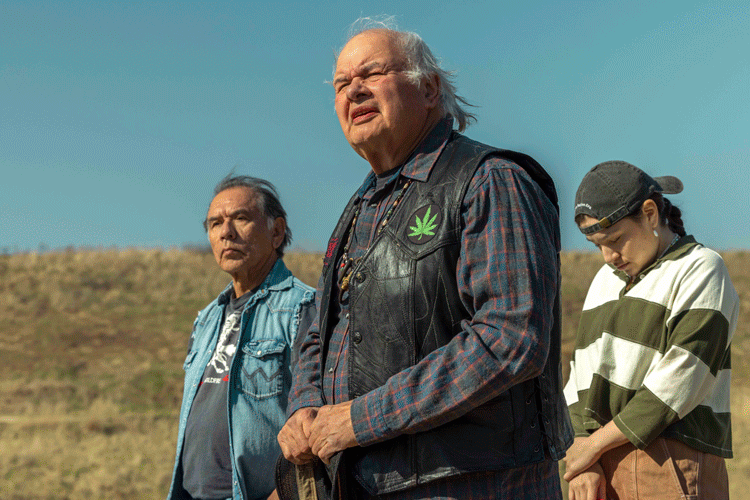Cable Takes a Page From the Networks’ Old Playbook
- Share via
In the wrenching last act of the TV movie “Brian’s Song”--a three-hankie affair if there ever was one--dying football player Brian Piccolo hoarsely croaks to teammate Gale Sayers, “It’s fourth and eight, and they won’t let me punt.”
Although that was 30 years ago, the made-for-TV movie format faces a similar quandary at the major networks, even as cable channels demonstrate their enthusiasm to pick up that fumble and run with it.
The chicken-and-egg question is whether the major networks are bailing out on TV movies because of declining ratings or if ratings have declined because programmers couldn’t figure out how to transform the genre to fit the 21st century--an age when hooking viewers awash in channels makes promoting one-time telecasts less productive than a series that will be there week after week.
What has become clear is that cable channels, by appealing to a smaller audience base, have found ways to make original movies work for them, tackling the sort of provocative subject matter that was a signature of long-form fare back when ABC, CBS and NBC each programmed a Sunday night movie--from the incest-themed “Something About Amelia” to nuclear holocaust in “The Day After” to sweeping “novels for television,” among them “Rich Man, Poor Man,” “The Thorn Birds” and “Shogun.”
Flash forward to last week, when NBC announced plans to eliminate its Sunday movie in the fall, after a series of high-profile failures that included the Kennedy family saga “Women of Camelot” and biographies of John Lennon and Natalie Cole. CBS, with several drama series from big-name producers on the drawing board, could drop one of its movie slots as well, and ABC has already retreated to a limited, event-oriented strategy mixing feature films and made-for-TV movies once the “Monday Night Football” season ends.
All this adds up to bad news for producers and crews who have traditionally made a living in what is known as “long-form programming”--an estimated $800-million-to-$1-billion annual business in its heyday, which some say has been run into the ground through a combination of neglect, mismanagement and failure to adapt to a shifting marketplace.
Balancing those scales a bit, meanwhile, have been cable channels such as the A&E; network, which claimed the best miniseries Emmy in 1999 for its period adventure “Horatio Hornblower,” as well as nominations for the movie “Dash and Lilly” that year and miniseries “P.T. Barnum” the next. The network also set viewing records with “The Crossing”--a historical account about George Washington that, in network circles, sounds as treacherous and rickety as wooden teeth.
A&E;’s upcoming offerings include a pair of sequels to “Hornblower” that will be shown in April; a remake of Orson Welles’ “The Magnificent Ambersons”; and “Shackleton,” with Kenneth Branagh as a British explorer who tried reaching the South Pole in the early 1900s.
The channel has also given the production go-ahead to “The Lost Battalion,” a fact-based World War I tale starring “NYPD Blue’s” Rick Schroder as the leader of an expeditionary unit trapped in German-occupied territory.
*
Allen Sabinson, A&E;’s senior vice president of programming, has made his own network-to-cable shift, having headed ABC’s movie department in the 1980s. During his ABC tenure, he presided over unauthorized TV movies about the lives of Rock Hudson and Liberace and another regarding the Challenger shuttle explosion--until the network publicly announced it was getting out of the sensational “docudrama” business.
“It’s a lot more fun making ‘The Magnificent Ambersons’ than ‘Shattered Vows,’ ” Sabinson quipped, referring to a 1984 ABC movie that starred Valerie Bertinelli as a beautiful young nun who falls in love with a priest.
As Sabinson points out, the TV movie’s decline on the major networks is a complex story almost 20 years in the making. In one corner stood cable networks such as HBO--then lacking the resources and expertise to mount prime-time series--who seized on movies as a means to garner attention and publicity.
At the same time, the major networks fell back on what became a limited formula, producing contemporary true-crime tales and emotional stories of hardship and triumph, designed principally to entice women.
“They became almost an anthological series,” Sabinson observed. “Each week was a different woman in jeopardy.”
Moreover, as the network audience continued to splinter, it became increasingly difficult to promote more intricate topics. This dynamic prompted the networks to rely on biographies or headline-grabbing accounts, as defined recently by CBS’ O.J. Simpson defense team production “American Tragedy” and JonBenet Ramsey miniseries “Perfect Murder, Perfect Town.”
Lately, however, even instantly recognizable premises easily distilled to a 30-second promo have mostly fizzled ratings-wise; in fact, only one TV movie or miniseries installment this season--Part 1 of ABC’s Judy Garland biography “Me and My Shadows”--has cracked the 20 million viewer mark, compared with a half-dozen last season and 16 during the 1998-99 campaign.
Though the TV movie has had a way of coming up with last-gasp saviors, even ABC’s new version of “South Pacific”--the beneficiary of promos during Sunday’s Oscar telecast--yielded merely solid but unspectacular results. Despite winning Monday night with nearly 16 million viewers, the classic musical played primarily to an older audience, under-performing among the young adults coveted by advertisers, whom networks must reach to justify mounting such lavish fare.
Cable networks, by contrast, are free to be more selective. “When you’re doing eight movies a year, as we do, you can handcraft them,” Sabinson noted.
*
In addition, cable programmers explore narrower topics as they seek to reinforce their “brand”--skewing, in the case of A&E;, toward material that can be shown again and again without appearing dated.
“The whole cable model has to be about creating an asset. . . . The value is having something of evergreen quality,” Sabinson explained. “ ‘The Great Gatsby’ is not, ‘I read about that murder case, and I’m interested in it now, but two weeks from now I’ll be bored with it.’ ”
Cable channels also woo big-name talent to television by offering them the kind of meaty roles they don’t often find in a multiplex or major network. As Sabinson put it, “When a movie actor does an A&E; movie they receive a fraction of their [usual] fee . . . [so] you better create an experience and an environment where they think it was worth it.”
It’s also true that cable networks needn’t amass the same vast audience broadcast networks do, since they garner additional revenue from subscribers and aren’t wholly dependent (or in the case of HBO and Showtime, dependent at all) on advertising.
That said, Sabinson rejects the premise cable is TV’s art house--a pristine arena unfettered by commercial concerns. “ ‘Art house’ is too exclusionary. We’re not snobs,” he said. “[But] there is a huge adult population that’s underserved, that’s hungry for things that have something to say, that have some complexity.”
Whatever the reason, pieces about troops behind German lines--from “Lost Battalion” to HBO’s upcoming World War II epic “Band of Brothers”--generally seem verboten at the major networks, which delve into history of late only if there is a compilation CD tie-in to market. And though NBC enjoyed great success in the 1990s under former TV movie czar Lindy DeKoven with miniseries rooted in mythology, history, even the Bible, flameouts by productions such as “The Magical Legend of the Leprechauns” in 1999 only fueled fears of gambling on such expensive projects.
A&E; also grapples with risk, Sabinson stressed, and must be creative to underwrite ventures such as “Lost Battalion,” which will shoot in Luxembourg with Fox TV Studios helping finance production. Sabinson first optioned the rights while an executive at TNT, only to have producer David Gerber bring them back to him years later, after that network passed.
“My job is mining for gold,” Sabinson explained. “I’m out there with a pan in the river, and most of it is sand.”
The image of that river serves as a fitting metaphor for the TV movie business, where the mother lode is elusive and a slow, steady current can wash away the gems.
*
Brian Lowry’s column appears on Wednesdays. He can be reached by e-mail at [email protected].
(BEGIN TEXT OF INFOBOX / INFOGRAPHIC)
Losing Yardage
Viewing of made-for-TV movies and miniseries on the major networks has been steadily declining, based on a survey of the 10 most watched movies and episodes of miniseries on ABC, CBS and NBC the past three years.
Avg. audience in millions
1998-1999
Top movies: 21.4
Top miniseries: 23.3
*
1999-2000
Top movies: 21
Top miniseries: 17.8
*
2000-2001
Top movies: 15.9
Top miniseries: 12.5
Sources: NBC, Nielsen Media Research
More to Read
The complete guide to home viewing
Get Screen Gab for everything about the TV shows and streaming movies everyone’s talking about.
You may occasionally receive promotional content from the Los Angeles Times.






